FIAT FULLBACK 2017 Owner handbook (in English)
Manufacturer: FIAT, Model Year: 2017, Model line: FULLBACK, Model: FIAT FULLBACK 2017Pages: 312, PDF Size: 12.31 MB
Page 121 of 312
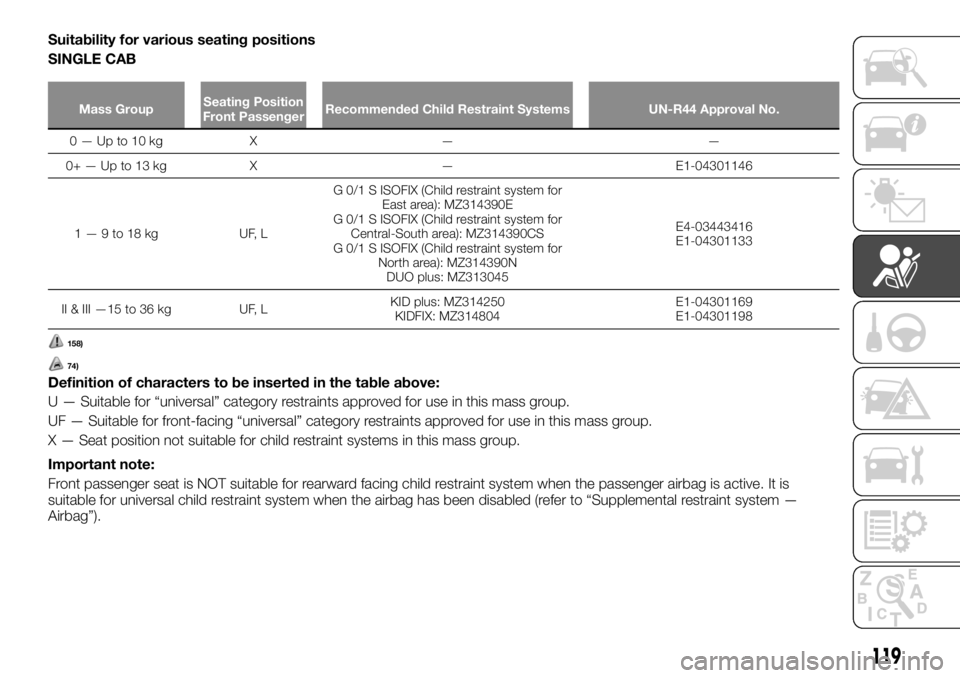
Suitability for various seating positions
SINGLE CAB
Mass GroupSeating Position
Front PassengerRecommended Child Restraint Systems UN-R44 Approval No.
0—Upto10kg X — —
0+ — Up to 13 kg X — E1-04301146
1—9to18kg UF,LG 0/1 S ISOFIX (Child restraint system for
East area): MZ314390E
G 0/1 S ISOFIX (Child restraint system for
Central-South area): MZ314390CS
G 0/1 S ISOFIX (Child restraint system for
North area): MZ314390N
DUO plus: MZ313045E4-03443416
E1-04301133
II & III —15 to 36 kg UF, LKID plus: MZ314250
KIDFIX: MZ314804E1-04301169
E1-04301198
158)
74)
Definition of characters to be inserted in the table above:
U — Suitable for “universal” category restraints approved for use in this mass group.
UF — Suitable for front-facing “universal” category restraints approved for use in this mass group.
X — Seat position not suitable for child restraint systems in this mass group.
Important note:
Front passenger seat is NOT suitable for rearward facing child restraint system when the passenger airbag is active. It is
suitable for universal child restraint system when the airbag has been disabled (refer to “Supplemental restraint system —
Airbag”).
119
Page 122 of 312
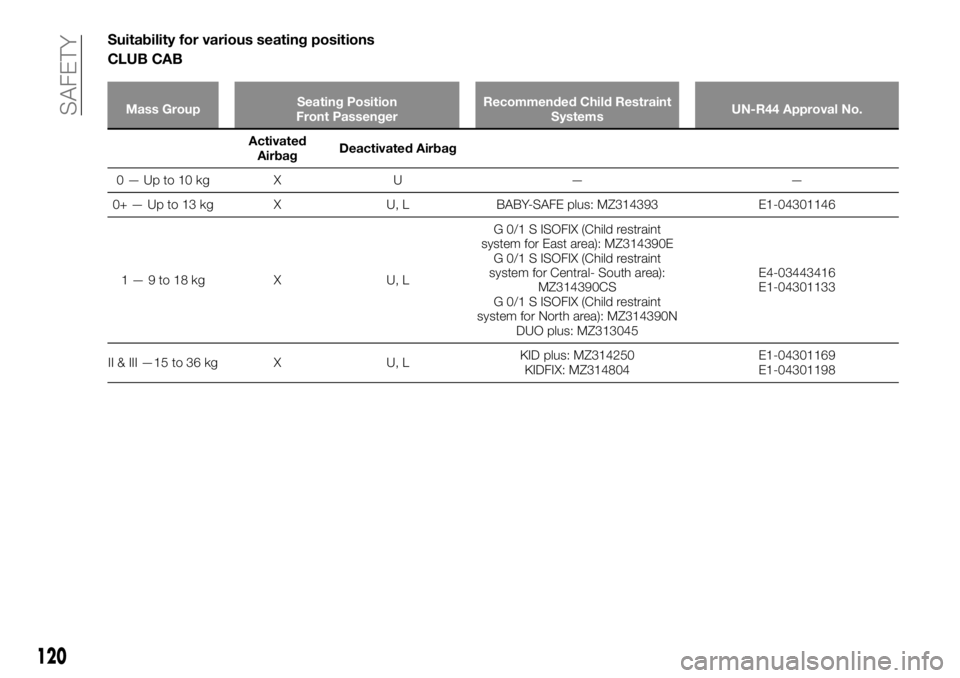
Suitability for various seating positions
CLUB CAB
Mass GroupSeating Position
Front PassengerRecommended Child Restraint
SystemsUN-R44 Approval No.
Activated
AirbagDeactivatedAirbag
0—Upto10kg X U — —
0+ — Up to 13 kg X U, L BABY-SAFE plus: MZ314393 E1-04301146
1—9to18kg X U,LG 0/1 S ISOFIX (Child restraint
system for East area): MZ314390E
G 0/1 S ISOFIX (Child restraint
system for Central- South area):
MZ314390CS
G 0/1 S ISOFIX (Child restraint
system for North area): MZ314390N
DUO plus: MZ313045E4-03443416
E1-04301133
II & III —15 to 36 kg X U, LKID plus: MZ314250
KIDFIX: MZ314804E1-04301169
E1-04301198
120
SAFETY
Page 123 of 312
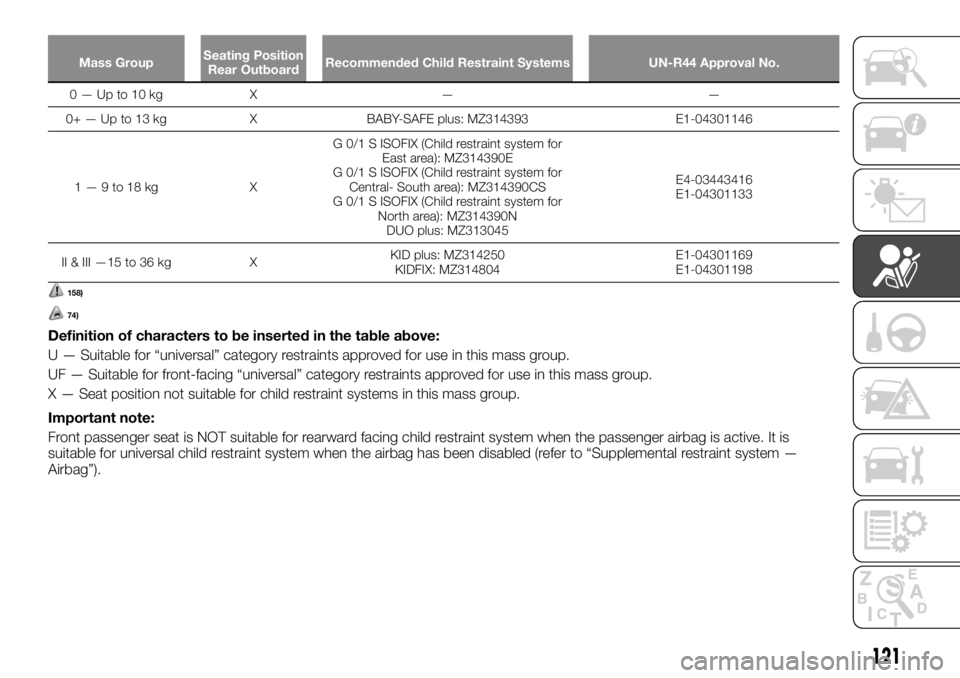
Mass GroupSeating Position
Rear OutboardRecommended Child Restraint Systems UN-R44 Approval No.
0—Upto10kg X — —
0+— Up to 13 kg X BABY-SAFE plus: MZ314393 E1-04301146
1—9to18kg XG 0/1 S ISOFIX (Child restraint system for
East area): MZ314390E
G 0/1 S ISOFIX (Child restraint system for
Central- South area): MZ314390CS
G 0/1 S ISOFIX (Child restraint system for
North area): MZ314390N
DUO plus: MZ313045E4-03443416
E1-04301133
II & III —15 to 36 kg XKID plus: MZ314250
KIDFIX: MZ314804E1-04301169
E1-04301198
158)
74)
Definition of characters to be inserted in the table above:
U — Suitable for “universal” category restraints approved for use in this mass group.
UF — Suitable for front-facing “universal” category restraints approved for use in this mass group.
X — Seat position not suitable for child restraint systems in this mass group.
Important note:
Front passenger seat is NOT suitable for rearward facing child restraint system when the passenger airbag is active. It is
suitable for universal child restraint system when the airbag has been disabled (refer to “Supplemental restraint system —
Airbag”).
121
Page 124 of 312
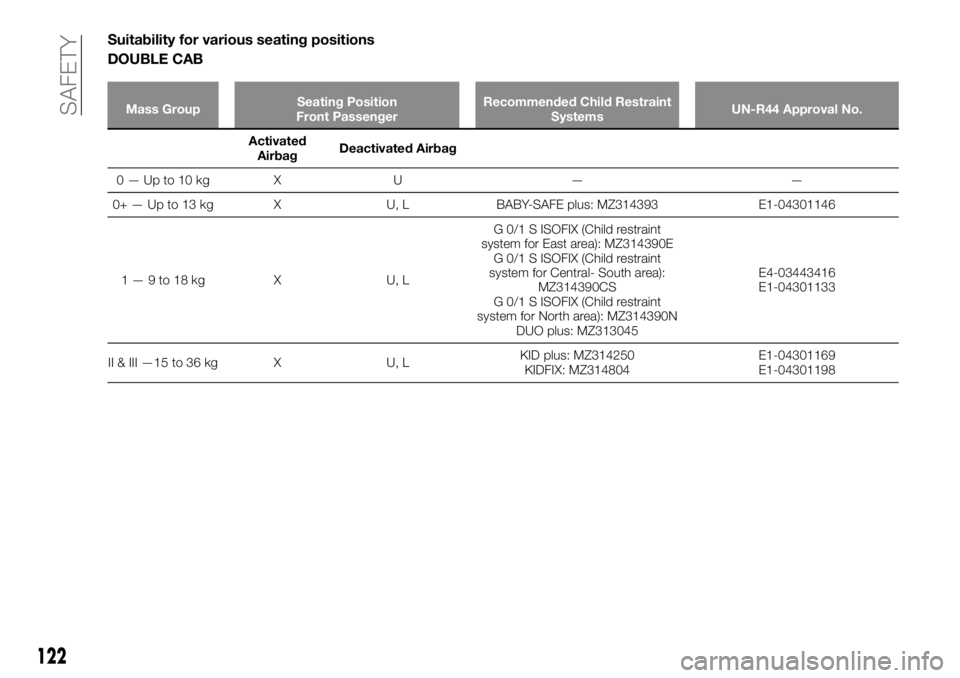
Suitability for various seating positions
DOUBLE CAB
Mass GroupSeating Position
Front PassengerRecommended Child Restraint
SystemsUN-R44 Approval No.
Activated
AirbagDeactivatedAirbag
0—Upto10kg X U — —
0+ — Up to 13 kg X U, L BABY-SAFE plus: MZ314393 E1-04301146
1—9to18kg X U,LG 0/1 S ISOFIX (Child restraint
system for East area): MZ314390E
G 0/1 S ISOFIX (Child restraint
system for Central- South area):
MZ314390CS
G 0/1 S ISOFIX (Child restraint
system for North area): MZ314390N
DUO plus: MZ313045E4-03443416
E1-04301133
II & III —15 to 36 kg X U, LKID plus: MZ314250
KIDFIX: MZ314804E1-04301169
E1-04301198
122
SAFETY
Page 125 of 312
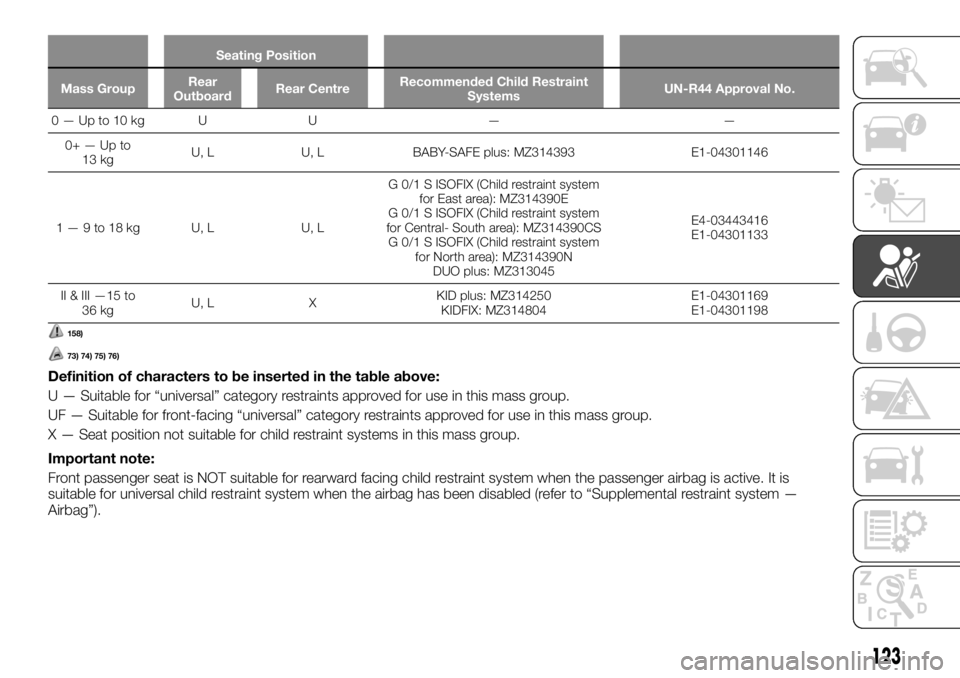
Seating Position
Mass GroupRear
OutboardRear CentreRecommended Child Restraint
SystemsUN-R44 Approval No.
0—Upto10kg U U — —
0+—Upto
13 kgU, L U, L BABY-SAFE plus: MZ314393 E1-04301146
1—9to18kg U,L U,LG 0/1 S ISOFIX (Child restraint system
for East area): MZ314390E
G 0/1 S ISOFIX (Child restraint system
for Central- South area): MZ314390CS
G 0/1 S ISOFIX (Child restraint system
for North area): MZ314390N
DUO plus: MZ313045E4-03443416
E1-04301133
II & III —15 to
36 kgU, L XKID plus: MZ314250
KIDFIX: MZ314804E1-04301169
E1-04301198
158)
73) 74) 75) 76)
Definition of characters to be inserted in the table above:
U — Suitable for “universal” category restraints approved for use in this mass group.
UF — Suitable for front-facing “universal” category restraints approved for use in this mass group.
X — Seat position not suitable for child restraint systems in this mass group.
Important note:
Front passenger seat is NOT suitable for rearward facing child restraint system when the passenger airbag is active. It is
suitable for universal child restraint system when the airbag has been disabled (refer to “Supplemental restraint system —
Airbag”).
123
Page 126 of 312
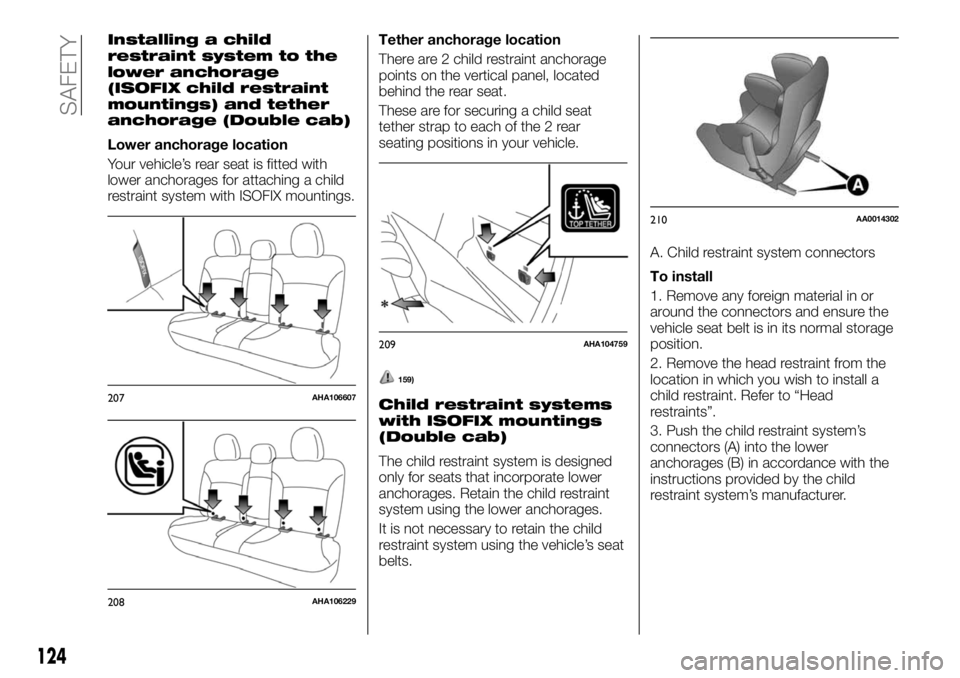
Installing a child
restraint system to the
lower anchorage
(ISOFIX child restraint
mountings) and tether
anchorage (Double cab)
Lower anchorage location
Your vehicle’s rear seat is fitted with
lower anchorages for attaching a child
restraint system with ISOFIX mountings.Tether anchorage location
There are 2 child restraint anchorage
points on the vertical panel, located
behind the rear seat.
These are for securing a child seat
tether strap to each of the 2 rear
seating positions in your vehicle.
159)
Child restraint systems
with ISOFIX mountings
(Double cab)
The child restraint system is designed
only for seats that incorporate lower
anchorages. Retain the child restraint
system using the lower anchorages.
It is not necessary to retain the child
restraint system using the vehicle’s seat
belts.A. Child restraint system connectors
To install
1. Remove any foreign material in or
around the connectors and ensure the
vehicle seat belt is in its normal storage
position.
2. Remove the head restraint from the
location in which you wish to install a
child restraint. Refer to “Head
restraints”.
3. Push the child restraint system’s
connectors (A) into the lower
anchorages (B) in accordance with the
instructions provided by the child
restraint system’s manufacturer.
207AHA106607
208AHA106229
209AHA104759
210AA0014302
124
SAFETY
Page 127 of 312
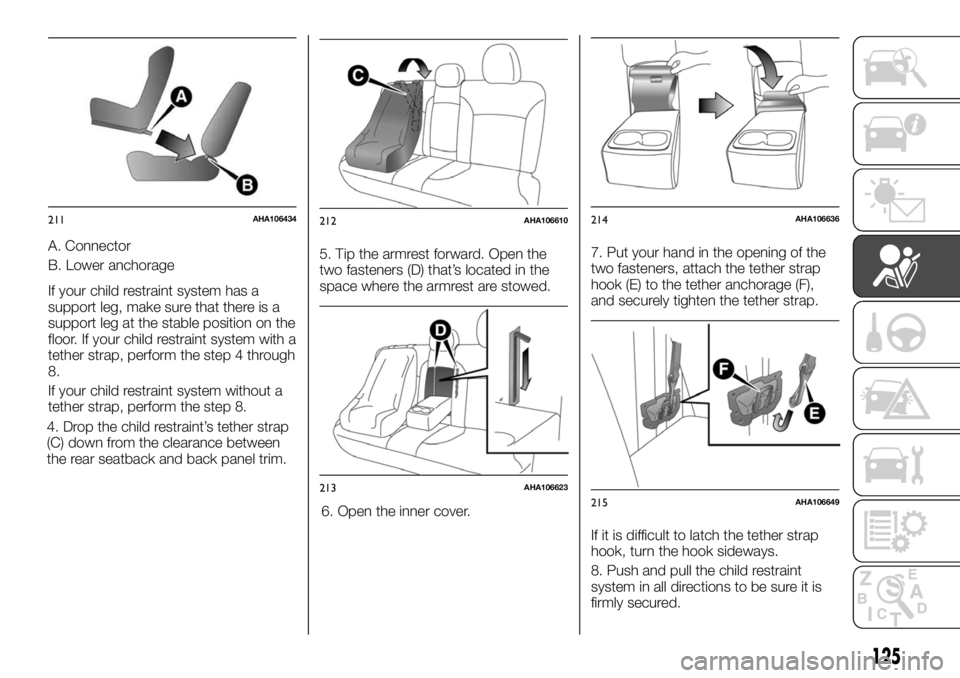
A. Connector
B. Lower anchorage
If your child restraint system has a
support leg, make sure that there is a
support leg at the stable position on the
floor. If your child restraint system with a
tether strap, perform the step 4 through
8.
If your child restraint system without a
tether strap, perform the step 8.
4. Drop the child restraint’s tether strap
(C) down from the clearance between
the rear seatback and back panel trim.5. Tip the armrest forward. Open the
two fasteners (D) that’s located in the
space where the armrest are stowed.
6. Open the inner cover.7. Put your hand in the opening of the
two fasteners, attach the tether strap
hook (E) to the tether anchorage (F),
and securely tighten the tether strap.
If it is difficult to latch the tether strap
hook, turn the hook sideways.
8. Push and pull the child restraint
system in all directions to be sure it is
firmly secured.
211AHA106434212AHA106610
213AHA106623
214AHA106636
215AHA106649
125
Page 128 of 312
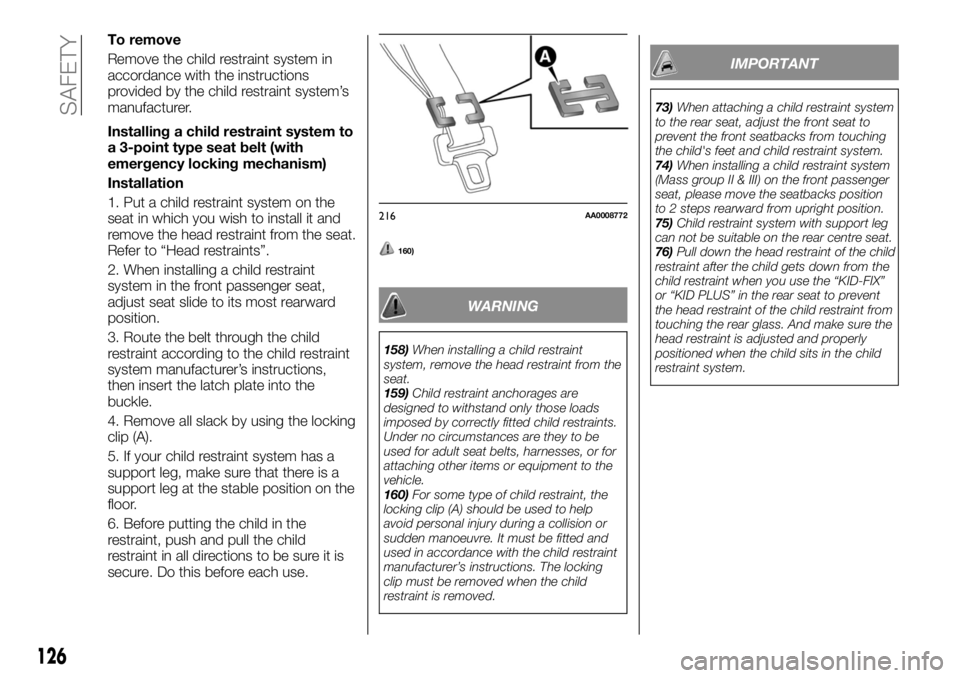
To remove
Remove the child restraint system in
accordance with the instructions
provided by the child restraint system’s
manufacturer.
Installing a child restraint system to
a 3-point type seat belt (with
emergency locking mechanism)
Installation
1. Put a child restraint system on the
seat in which you wish to install it and
remove the head restraint from the seat.
Refer to “Head restraints”.
2. When installing a child restraint
system in the front passenger seat,
adjust seat slide to its most rearward
position.
3. Route the belt through the child
restraint according to the child restraint
system manufacturer’s instructions,
then insert the latch plate into the
buckle.
4. Remove all slack by using the locking
clip (A).
5. If your child restraint system has a
support leg, make sure that there is a
support leg at the stable position on the
floor.
6. Before putting the child in the
restraint, push and pull the child
restraint in all directions to be sure it is
secure. Do this before each use.
160)
WARNING
158)When installing a child restraint
system, remove the head restraint from the
seat.
159)Child restraint anchorages are
designed to withstand only those loads
imposed by correctly fitted child restraints.
Under no circumstances are they to be
used for adult seat belts, harnesses, or for
attaching other items or equipment to the
vehicle.
160)For some type of child restraint, the
locking clip (A) should be used to help
avoid personal injury during a collision or
sudden manoeuvre. It must be fitted and
used in accordance with the child restraint
manufacturer’s instructions. The locking
clip must be removed when the child
restraint is removed.
IMPORTANT
73)When attaching a child restraint system
to the rear seat, adjust the front seat to
prevent the front seatbacks from touching
the child's feet and child restraint system.
74)When installing a child restraint system
(Mass group II & III) on the front passenger
seat, please move the seatbacks position
to 2 steps rearward from upright position.
75)Child restraint system with support leg
can not be suitable on the rear centre seat.
76)Pull down the head restraint of the child
restraint after the child gets down from the
child restraint when you use the “KID-FIX”
or “KID PLUS” in the rear seat to prevent
the head restraint of the child restraint from
touching the rear glass. And make sure the
head restraint is adjusted and properly
positioned when the child sits in the child
restraint system.
216AA0008772
126
SAFETY
Page 129 of 312
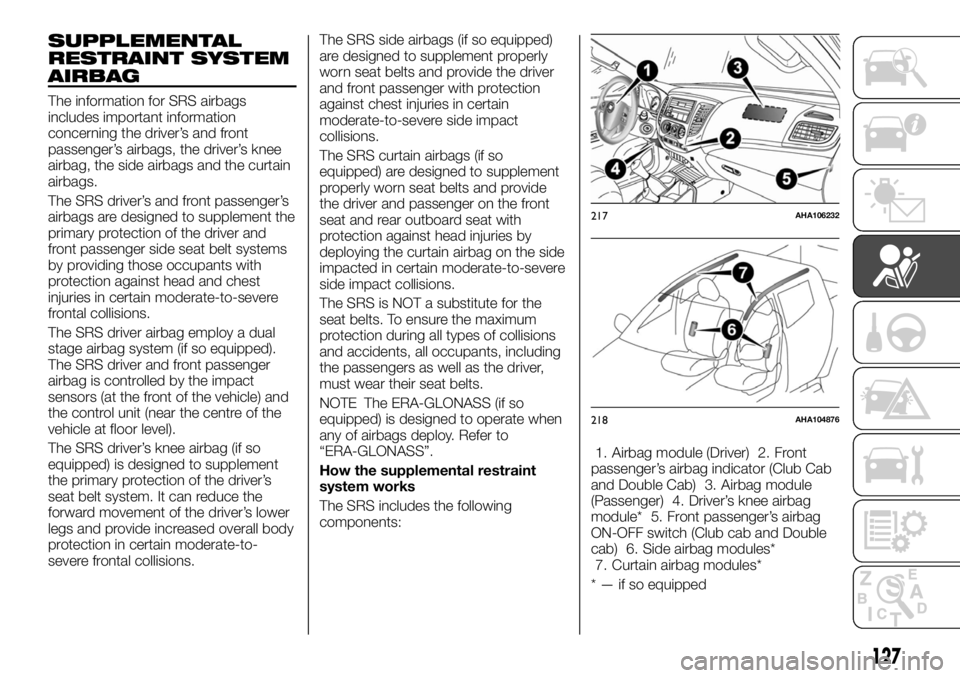
SUPPLEMENTAL
RESTRAINT SYSTEM
AIRBAG
The information for SRS airbags
includes important information
concerning the driver’s and front
passenger’s airbags, the driver’s knee
airbag, the side airbags and the curtain
airbags.
The SRS driver’s and front passenger’s
airbags are designed to supplement the
primary protection of the driver and
front passenger side seat belt systems
by providing those occupants with
protection against head and chest
injuries in certain moderate-to-severe
frontal collisions.
The SRS driver airbag employ a dual
stage airbag system (if so equipped).
The SRS driver and front passenger
airbag is controlled by the impact
sensors (at the front of the vehicle) and
the control unit (near the centre of the
vehicle at floor level).
The SRS driver’s knee airbag (if so
equipped) is designed to supplement
the primary protection of the driver’s
seat belt system. It can reduce the
forward movement of the driver’s lower
legs and provide increased overall body
protection in certain moderate-to-
severe frontal collisions.The SRS side airbags (if so equipped)
are designed to supplement properly
worn seat belts and provide the driver
and front passenger with protection
against chest injuries in certain
moderate-to-severe side impact
collisions.
The SRS curtain airbags (if so
equipped) are designed to supplement
properly worn seat belts and provide
the driver and passenger on the front
seat and rear outboard seat with
protection against head injuries by
deploying the curtain airbag on the side
impacted in certain moderate-to-severe
side impact collisions.
The SRS is NOT a substitute for the
seat belts. To ensure the maximum
protection during all types of collisions
and accidents, all occupants, including
the passengers as well as the driver,
must wear their seat belts.
NOTE The ERA-GLONASS (if so
equipped) is designed to operate when
any of airbags deploy. Refer to
“ERA-GLONASS”.
How the supplemental restraint
system works
The SRS includes the following
components:1. Airbag module (Driver) 2. Front
passenger’s airbag indicator (Club Cab
and Double Cab) 3. Airbag module
(Passenger) 4. Driver’s knee airbag
module* 5. Front passenger’s airbag
ON-OFF switch (Club cab and Double
cab) 6. Side airbag modules*
7. Curtain airbag modules*
* — if so equipped
217AHA106232
218AHA104876
127
Page 130 of 312
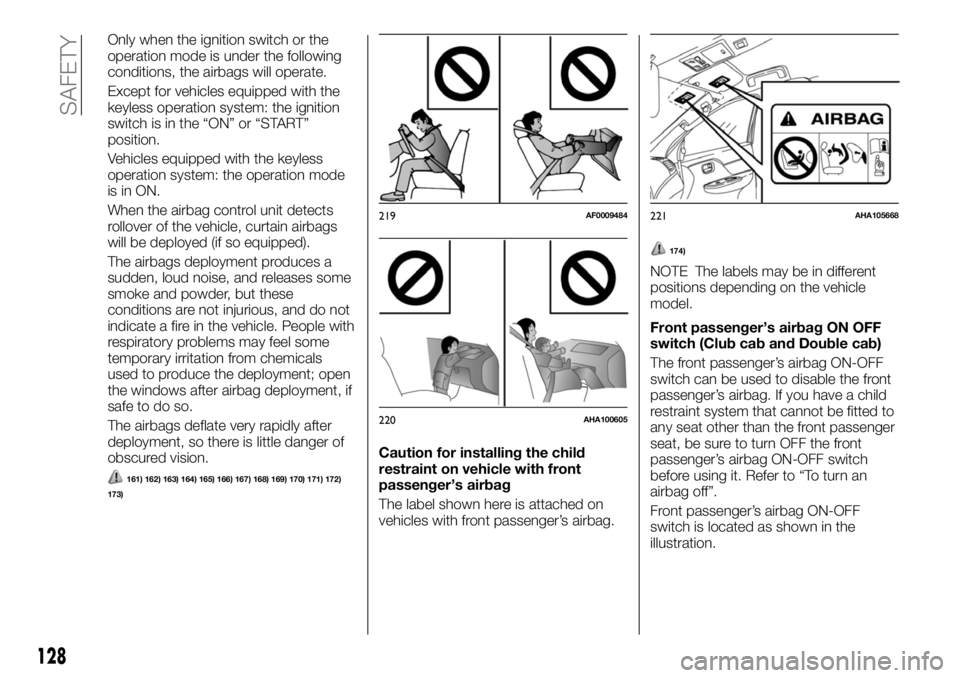
Only when the ignition switch or the
operation mode is under the following
conditions, the airbags will operate.
Except for vehicles equipped with the
keyless operation system: the ignition
switch is in the “ON” or “START”
position.
Vehicles equipped with the keyless
operation system: the operation mode
is in ON.
When the airbag control unit detects
rollover of the vehicle, curtain airbags
will be deployed (if so equipped).
The airbags deployment produces a
sudden, loud noise, and releases some
smoke and powder, but these
conditions are not injurious, and do not
indicate a fire in the vehicle. People with
respiratory problems may feel some
temporary irritation from chemicals
used to produce the deployment; open
the windows after airbag deployment, if
safe to do so.
The airbags deflate very rapidly after
deployment, so there is little danger of
obscured vision.
161) 162) 163) 164) 165) 166) 167) 168) 169) 170) 171) 172)
173)
Caution for installing the child
restraint on vehicle with front
passenger’s airbag
The label shown here is attached on
vehicles with front passenger’s airbag.
174)
NOTE The labels may be in different
positions depending on the vehicle
model.
Front passenger’s airbag ON OFF
switch (Club cab and Double cab)
The front passenger’s airbag ON-OFF
switch can be used to disable the front
passenger’s airbag. If you have a child
restraint system that cannot be fitted to
any seat other than the front passenger
seat, be sure to turn OFF the front
passenger’s airbag ON-OFF switch
before using it. Refer to “To turn an
airbag off”.
Front passenger’s airbag ON-OFF
switch is located as shown in the
illustration.
219AF0009484
220AHA100605
221AHA105668
128
SAFETY